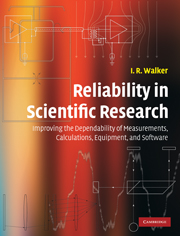 Reliability in Scientific Research
Reliability in Scientific Research Published online by Cambridge University Press: 05 June 2012
Introduction
Leaks in vacuum systems are an age-old and common problem in scientific research. Although they are nuisances in many situations, leaks are generally most troublesome when they appear in ultrahigh vacuum (UHV) systems and cryogenic apparatus. In both cases, even minuscule leaks, which are difficult to detect and can be intermittent, may be sufficient to disable the equipment. The thermal stresses on both types of equipment can cause cracks to form in the vacuum envelopes and joints that can lead to leaks. Turn-around periods for these systems can be very long. In the case of UHV devices, bakeout of the vacuum chambers is usually required, which may take a day or more. In order to use cryogenic apparatus, one must usually cool down and warm up the equipment very slowly. Time scales for this range from about an hour to a day or more, depending on the type of equipment. Hence, the leak testing of these systems can be very time-consuming and nerve-wracking.
In the case of cryogenic systems in particular, the relative fragility of the equipment, and the presence of large thermal and mechanical stresses during the routine operation and handling of these devices, promotes the formation of leaks. In these systems, leaks may occur only when the apparatus is cold, and therefore often inaccessible to direct investigation.
To save this book to your Kindle, first ensure [email protected] is added to your Approved Personal Document E-mail List under your Personal Document Settings on the Manage Your Content and Devices page of your Amazon account. Then enter the ‘name’ part of your Kindle email address below. Find out more about saving to your Kindle.
Note you can select to save to either the @free.kindle.com or @kindle.com variations. ‘@free.kindle.com’ emails are free but can only be saved to your device when it is connected to wi-fi. ‘@kindle.com’ emails can be delivered even when you are not connected to wi-fi, but note that service fees apply.
Find out more about the Kindle Personal Document Service.
To save content items to your account, please confirm that you agree to abide by our usage policies. If this is the first time you use this feature, you will be asked to authorise Cambridge Core to connect with your account. Find out more about saving content to Dropbox.
To save content items to your account, please confirm that you agree to abide by our usage policies. If this is the first time you use this feature, you will be asked to authorise Cambridge Core to connect with your account. Find out more about saving content to Google Drive.